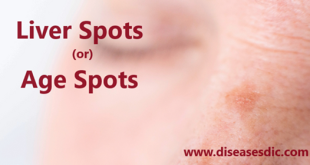Definition
A seborrheic keratosis is a growth on the skin. The growth is not cancer (benign). It’s a brown or black raised area. Seborrheic keratoses often appear on a person’s chest, arms, back, or other areas. They’re very common in people older than age 50, but younger adults can get them as well. With age, more and more people get 1 or more of these growths.
Seborrheic keratosis
The outer layer of your skin is the epidermis. Cells called keratinocytes to make up much of this layer. These cells regularly flake off as younger cells replace them. Sometimes keratinocytes grow in greater numbers than usual. This can lead to a keratosis. You may have just one. Or you may have a dozen or a hundred or more of these growths. In most cases, these growths only cause cosmetic problems. In some cases, they can cause skin irritation if they’re in a spot that clothes rub. Seborrheic keratoses are not cancer. But they can sometimes look like growths that are cancer. Because of this, your healthcare provider may need to take a sample and examine it.
Epidemiology
In 2000, a British population younger than 40 years that 8.3% of the males and 16.7% of the females had at least one seborrheic keratosis. In an Australian population, 23.5% of individuals aged 15-30 years were found to have at least one seborrheic keratosis, with no significant differences between the sexes. In another Australian study of 100 people composed of hospital staff and non-dermatologic day patients, 12% of people aged 15-25 years (n = 34), 79% of people aged 26-50 years (n = 24), 100% of people aged 51-75 years (n = 25), and 100% of people older than 75 years (n = 17) had seborrheic keratoses. The median number of seborrheic keratoses per person was 6 in the group aged 15-25 years, 5 in the group aged 26-50 years, 23 in the group aged 51-75 years, and 69 in those older than 75 years.
Types of seborrheic keratosis
Inflamed seborrheic keratosis contains an abundant of inflammatory infiltrate with lichenoid qualities. They have an inflammatory infiltrate composed typically of mononuclear cells, melanophages, or both. In some extreme cases, the entire seborrheic keratosis undergoes regression, evidenced by remnants of the original lesion and a clinical history of a lesion that changed.
Irritated seborrheic keratoses are produced by trauma, often picked by the patient. They are associated with HPV infection, horn cysts and pseudonym cysts with a range of keratinization patterns, from fully orthokeratotic to mixed patterns to parakeratotic. Melanoacanthoma is characterized by an interspersed mixture of non-pigmented keratinocytes and dendritic melanocytes. The epithelial thickness is variable but usually thicker than the adjacent skin.
Irritated seborrheic keratoses
Clonal seborrheic keratosis contains numerous basaloid, pigmented keratinocytes with disintegrated desmosomes.
Clonal seborrheic keratosis
Melanotic seborrheic keratoses contain numerous basaloid, pigmented keratinocytes, in contrast with melanoacanthoma, in which melanin is contained in dendritic melanocytes. In Pleomorphic types, a considerable number of keratinocytes is detected, the significance of which is not fully known. Genital seborrheic keratoses are quite difficult to differentiate from both pigmented genital warts and HPV-related intraepithelial neoplasia.
Genital seborrheic keratoses occur in solitary, resemble pigmented basal cell carcinomas, and have a scale. These features enable one to differentiate between different keratosis types.
Risk factors
- People over the age of 50 are most likely to develop seborrheic keratosis, although its exact cause is not yet known.
- People with a family history of this condition also are more likely to develop it.
Causes of seborrheic keratosis
The seborrheic keratoses do not result from sebaceous glands and do not show distribution like that in the case of seborrheic dermatitis. Hence, the exact cause of the ailment is unknown. Over the years seborrheic keratoses cases have increased in number. Also, in other cases, the condition can be inherited and can show numerous keratoses. It can be said that:
- Seborrheic keratosis can occur as a result of sun exposure or prolonged dermatitis.
- They are commonly seen in and around skin folds such as on the neck or in the underarms indicating that friction between skin folds might be the reason for an eruption.
- They cannot be linked to a viral infection like that of the human papillomavirus.
- Research on seborrheic keratosis shows activation and mutation of certain genes which are stable, though they are hereditary, of the epidermal keratinocyte cells.
- They do not encourage mutations such as tumor suppressor gene mutation but, can be linked to exposure of UV radiations
Symptoms
Seborrheic keratoses can itch, bleed easily, or become red and irritated when clothing rubs them.
How the growths look can vary widely. They:
- Range in size from tiny to larger than 1 in. (3 cm) in diameter.
- Range in texture from waxy and smooth to velvety to dry, rough, and bumpy.
- Range in color from white to light tan to black. Most are brown. Some are multicolored.
They also:
- May have a dry scalp, which you can easily pick off, or have a surface that crumbles when picked.
- Can be dome-shaped with tiny white or black “horns” growing from the surface.
- Can occur as a single growth or a cluster of growths.
- Can look like skin tags (small, soft pieces of skin that stick out on a thin stem).
- Can swell and turn red.
These growths may be mistaken for warts, moles, skin tags, or melanoma (skin cancer).
Complications of seborrheic keratosis
- There is a fair chance of skin cancer to arise at the site of the seborrheic keratosis.
- In rare cases, elevated seborrheic keratoses may contain underlying malignancy. This paraneoplastic syndrome is often denoted as the sign of Leser-Trelat.
- An inflamed, irritated, red lesion may result in eczematous dermatitis seen around the keratosis.
Diagnosis and test
A healthcare provider can often diagnose seborrheic keratoses based on how they look. In some cases, a biopsy may be needed.
If you have a skin growth that concerns you, it is always a good idea to see your healthcare provider. Your healthcare provider will ask you about your medical history and symptoms. Your healthcare provider will also give you a physical exam and closely examine the growth.
It’s important for your healthcare provider to make sure any growths are not cancer or pre-cancer. Some signs that may concern your healthcare provider may need to check the growth of cancer if:
- It looks smooth on the skin, instead of raised and well-defined
- It has blurred borders
- It’s not the same shape on both sides (asymmetry)
- There are dilated blood vessels around the growth
- There’s an open sore in the growth
- It grew out of a previous mole
If your healthcare provider wants to check for cancer, you will have a skin biopsy. Your healthcare provider will take a sample of the growth or the entire growth. It will then be checked under a microscope for cancer.
Treatment and medications
There are several ways to combat the non-aesthetic presentation of SKs. While there may be a medical cause to treat SKs (irritation, pain, itch), most SK removals are done for cosmetic reasons and not covered by medical insurance.
Topical keratolytics ( ammonium lactate, urea): This may help keep the skin smooth and minimize the presentation of lesions, especially smaller, scaly stucco keratoses on the arms, legs, and feet.
Topical retinoids: Continuous use of retinoids in the forms of anti-aging creams or chemical peels may keep skin exfoliated chronically so that SKs do not form. They may also improve existing lesions but may be a less effective treatment.
Cryotherapy: Destruction of SKs with liquid nitrogen in a health care provider’s office. Side effects include pain, swelling, skin discoloration, and incomplete removal.
Curettage: After anesthetizing the area, the lesion is removed with a round blade instrument. This may leave a superficial scar or discoloration to the area but typically provides more complete removal.
Electrodesiccation and curettage: Removal of the lesion with a round blade followed by cautery with a heat source to stop bleeding or further eliminate a lesion. This may lead to scarring and/or skin discoloration.
Surgical excision: For large lesions, excising the tissue may be necessary to give the best cosmetic outcome. While lesions are very superficial, an excision may minimize discoloration and scarring to a large area of skin.
Over-the-counter treatment modalities also exist, such as, but may not be effective since may not provide enough destruction to the lesion.
Prevention of seborrheic keratosis
- You’re likely to start by first seeing your primary care doctor. In some cases when you call to set up an appointment, you may be referred directly to a specialist in skin diseases (dermatologist).
- Because appointments can be brief, it’s a good idea to be well-prepared for your appointment. Here’s some information to help you get ready for your appointment.
 Diseases Treatments Dictionary This is complete solution to read all diseases treatments Which covers Prevention, Causes, Symptoms, Medical Terms, Drugs, Prescription, Natural Remedies with cures and Treatments. Most of the common diseases were listed in names, split with categories.
Diseases Treatments Dictionary This is complete solution to read all diseases treatments Which covers Prevention, Causes, Symptoms, Medical Terms, Drugs, Prescription, Natural Remedies with cures and Treatments. Most of the common diseases were listed in names, split with categories.








Please give the simplest or most common names of the medication and treatment of this skin ailment. Thank you
Good
how can I treatment wart on my hand
Please look into the post warts and its treatment.
I have more than two sole warts in each foot and I can’t walk well because they are very painful.
what can I do?
Consult with a doctor to get rid of the problem with an appropriate medication.
is there any oral medication to eradicate dermatosis papulosa nigra/ seborrheic keratosis. pls help me
Dermatosis papulosa nigra (DPN) and seborrheic keratosis (SK) are typically benign skin growths, and there are no specific oral medications to eradicate them. Removal procedures performed by dermatologists, such as cryotherapy, electrosurgery, laser therapy, or curettage, may be considered for eliminating these growths. Seeking professional guidance is crucial to determine the most appropriate removal method and avoid potential complications.